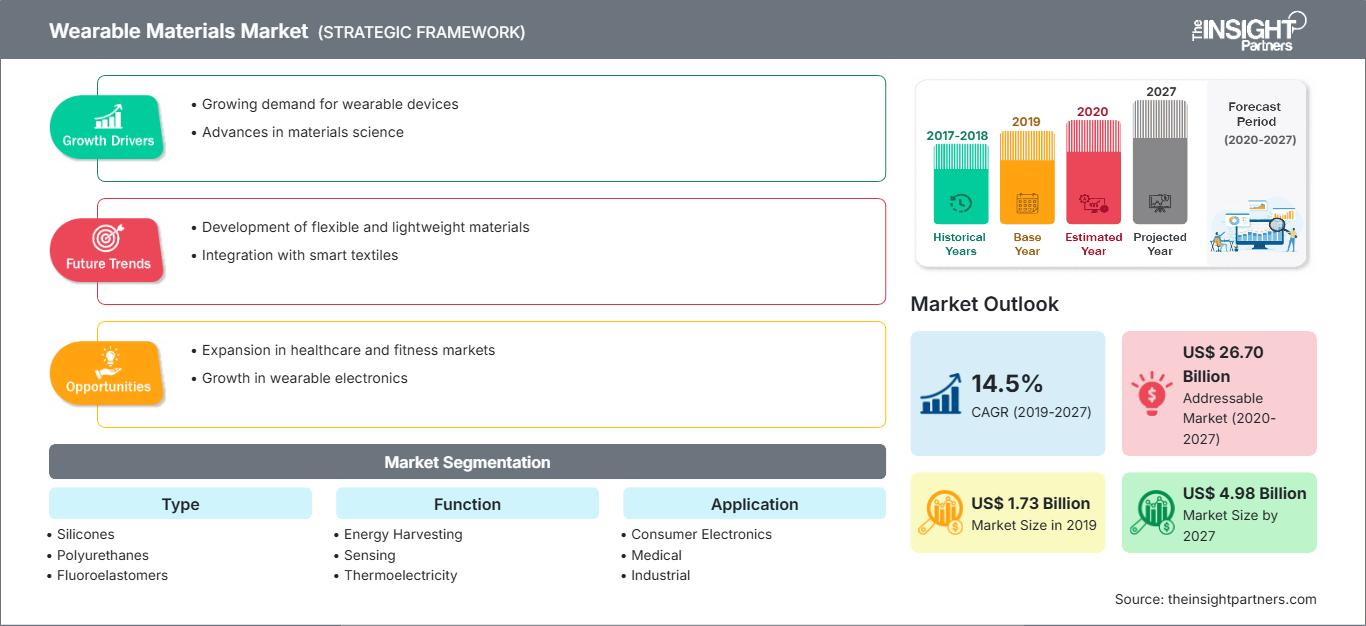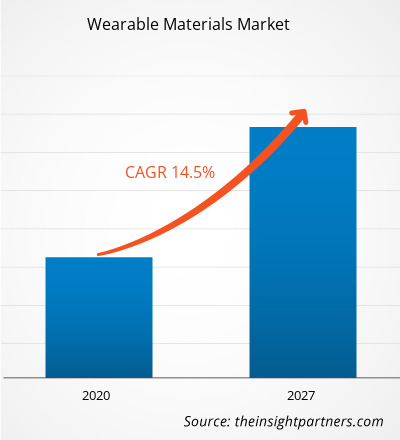Según The Insight Partners, el mercado de materiales para prendas de vestir se valoró en 1.732,67 millones de dólares estadounidenses en 2019 y se espera que crezca a una tasa de crecimiento anual compuesta (TCAC) del 14,5 % entre 2020 y 2027.
Los materiales para dispositivos vestibles se pueden utilizar de forma flexible en la producción de estos dispositivos y sus componentes, como sensores y baterías. Estos materiales poseen características distintivas, como permeabilidad, transparencia, adhesión y procesabilidad, además de ser biocompatibles. Asimismo, son muy respetuosos con la piel. El creciente uso de la tecnología vestible ha generado una demanda significativa de materiales que resistan el desgaste por el uso diario. Además, estos materiales son relativamente ligeros y se perciben como cómodos y flexibles, por lo que encuentran aplicaciones en diversos sectores. Se utilizan en la producción de pulseras de actividad, relojes inteligentes, monitores de actividad física y dispositivos médicos para evaluar el estado del cuerpo.
En 2019, Asia Pacífico fue el mayor mercado de materiales para prendas de vestir. La mayor cuota de mercado de la región se atribuye principalmente al aumento de la producción y el consumo de estos materiales en las economías desarrolladas y en desarrollo de Asia Pacífico. China se considera uno de los mercados más grandes, donde la demanda y la producción de materiales para prendas de vestir son significativamente altas. Otras economías que siguen la tendencia de crecimiento del mercado de materiales para prendas de vestir son Japón, India y Corea del Sur. Asia Pacífico contribuye significativamente al crecimiento del mercado de materiales para prendas de vestir debido a factores como la rápida urbanización, la creciente inclinación hacia productos tecnológicamente avanzados y el aumento de la renta disponible. Además, la presencia de importantes fabricantes en la región impulsa sustancialmente el crecimiento del mercado de materiales para prendas de vestir.
La pandemia de COVID-19 se originó en Wuhan, China, en diciembre de 2019 y, desde entonces, se ha propagado rápidamente por todo el mundo. En septiembre de 2020, Estados Unidos, India, Brasil, Rusia, Sudáfrica, México y el Reino Unido se encontraban entre los países más afectados en cuanto a casos confirmados y fallecimientos. El brote de COVID-19 ha impactado las economías y las industrias de diversos países debido a los confinamientos, las restricciones de viaje y el cierre de negocios. La industria química y de materiales es una de las principales afectadas, ya que enfrenta graves interrupciones, como el cierre de oficinas y fábricas y la ruptura de la cadena de suministro, como consecuencia de este brote.
Obtendrá personalización gratuita de cualquier informe, incluyendo partes de este informe, análisis a nivel de país y paquetes de datos de Excel. Además, podrá aprovechar excelentes ofertas y descuentos para empresas emergentes y universidades.
Mercado de materiales para prendas inteligentes: Perspectivas estratégicas

-
Obtenga las principales tendencias clave del mercado que se describen en este informe.Esta muestra GRATUITA incluirá análisis de datos, que abarcarán desde tendencias de mercado hasta estimaciones y pronósticos.
Perspectivas del mercado
Creciente demanda de dispositivos electrónicos portátiles y de vestir
Con la rápida innovación en digitalización y tecnología, se lanzan al mercado nuevos dispositivos portátiles, como pulseras de actividad, monitores de actividad física y relojes inteligentes, capaces de registrar los movimientos, la frecuencia cardíaca, etc. Muchas empresas del sector del fitness han comenzado a fabricar calcetines inteligentes para correr que registran datos como la velocidad, el tiempo y la distancia. La mayoría de los materiales para dispositivos portátiles están hechos de tejidos como la silicona, que es duradera y transpirable, y ofrece otras propiedades como una mejor adherencia, permeabilidad y transparencia. Actualmente, las empresas se centran en el diseño de materiales impresos para electrónica portátil y tejidos inteligentes que permitan optimizar costes y ofrecer versatilidad. Varios dispositivos, como las pulseras Fitbit, están fabricados con elastómero sin látex, un material flexible y ligero. Numerosas empresas e investigadores se concentran en el desarrollo de ropa inteligente con mejor conductividad eléctrica, fabricada con materiales flexibles y transpirables. Estas prendas se fabrican mediante un proceso especial de electrohilado que conglomera fibras de polímero con pequeños hilos de plata en estado líquido, para luego filtrarlas, secarlas y calentarlas. Estos materiales son resistentes al desgaste del uso diario. Por lo tanto, resulta evidente que la demanda de materiales para prendas de vestir aumentará continuamente, al igual que la demanda de dispositivos portátiles y la introducción de productos nuevos y avanzados.
Información sobre tipos
Según su tipo, el mercado de materiales para dispositivos vestibles se clasifica en siliconas, poliuretanos, fluoroelastómeros y otros. En 2019, el segmento de siliconas representó la mayor cuota del mercado global de materiales para dispositivos vestibles. La silicona es un material versátil, conocido por su permeabilidad, adhesión, facilidad de desprendimiento, transparencia y biocompatibilidad. Se considera que las siliconas no son citotóxicas. Son muy compatibles con la piel, con baja adhesión interfacial y mayor fluidez para una adhesión estable. Estos materiales pueden modificarse según requisitos específicos y, por lo tanto, se consideran ideales para aplicaciones en el cuidado de la piel. Además, en comparación con otros polímeros orgánicos, las siliconas son mucho más transpirables y cómodas de usar. Estos materiales se utilizan cada vez más en la producción de dispositivos médicos y electrónicos de consumo para dispositivos vestibles. Estos factores impulsan aún más el crecimiento del mercado de materiales para dispositivos vestibles a nivel mundial.
Información sobre funciones
Según su función, el mercado de materiales para dispositivos vestibles se segmenta en recolección de energía, sensores, termoelectricidad, luminiscencia, calentamiento y enfriamiento, entre otros. El segmento de sensores lideró el mercado de materiales para dispositivos vestibles con la mayor cuota de mercado en 2019. Los dispositivos vestibles se presentan en diversas formas: pulseras inteligentes, relojes, camisetas, zapatos, diademas, gafas y collares. La mayoría incorpora sensores que recopilan datos sin procesar y los envían a una base de datos o aplicación de software para su análisis. Con el crecimiento del mercado de dispositivos vestibles, la demanda de sensores ha aumentado significativamente.
Información de la aplicación
Según su aplicación, el mercado de materiales para dispositivos vestibles se segmenta en electrónica de consumo, medicina, industria y otros. El segmento de electrónica de consumo lideró el mercado de materiales para dispositivos vestibles en 2019, con la mayor cuota de mercado. La electrónica de consumo es la aplicación más extendida para estos materiales. Los dispositivos electrónicos vestibles de consumo incluyen diversos dispositivos relacionados con el fitness y el deporte, el entretenimiento y el multimedia, y la moda y la indumentaria. Factores como la creciente demanda de los consumidores y la rápida miniaturización de la tecnología de sensores han contribuido al crecimiento del mercado de dispositivos vestibles, lo que, a su vez, ha incrementado la demanda de materiales para estos dispositivos.
Arkema, Momentive, The Lubrizol Corporation, Wacker Chemie AG, Covestro AG, DSM, Solvay SA, Shin-Itsu, BASF SE y DuPont figuran entre los principales actores del mercado global de materiales para prendas inteligentes. Estos actores se centran en estrategias como fusiones y adquisiciones, así como en investigación y desarrollo, para ampliar su presencia geográfica y su base de consumidores a nivel mundial.
Perspectivas regionales del mercado de materiales para prendas de vestir
Los analistas de The Insight Partners han explicado en detalle las tendencias regionales y los factores que influyen en el mercado de materiales para prendas inteligentes durante el período de previsión. Esta sección también analiza los segmentos del mercado de materiales para prendas inteligentes y su distribución geográfica en Norteamérica, Europa, Asia Pacífico, Oriente Medio y África, y Sudamérica y Centroamérica.
Alcance del informe de mercado de materiales para prendas de vestir
| Atributo del informe | Detalles |
|---|---|
| Tamaño del mercado en 2019 | 1.730 millones de dólares estadounidenses |
| Tamaño del mercado para 2027 | 4.980 millones de dólares estadounidenses |
| Tasa de crecimiento anual compuesto global (2019 - 2027) | 14,5% |
| Datos históricos | 2017-2018 |
| período de previsión | 2020-2027 |
| Segmentos cubiertos |
Por tipo
|
| Regiones y países cubiertos |
América del norte
|
| Líderes del mercado y perfiles de empresas clave |
|
Densidad de los actores del mercado de materiales para prendas de vestir: comprensión de su impacto en la dinámica empresarial
El mercado de materiales para prendas inteligentes está creciendo rápidamente, impulsado por la creciente demanda de los usuarios finales debido a factores como la evolución de las preferencias de los consumidores, los avances tecnológicos y una mayor conciencia de los beneficios del producto. A medida que aumenta la demanda, las empresas amplían su oferta, innovan para satisfacer las necesidades de los consumidores y aprovechan las tendencias emergentes, lo que impulsa aún más el crecimiento del mercado.

- Obtenga una visión general de los principales actores del mercado de materiales para prendas de vestir.
Mercado global de materiales para prendas de vestir, por tipo
- siliconas
- Poliuretanos
- fluoroelastómeros
- Otros
Mercado global de materiales para prendas de vestir, por función
- Aprovechamiento de la energía
- Percepción
- Termoelectricidad
- Luminiscente
- Calentamiento y enfriamiento
- Otros
Mercado global de materiales para prendas de vestir, por aplicación
- Electrónica de consumo
- Médico
- Industrial
- Otros
Perfiles de empresas
- Arkema
- Momentáneo
- La Corporación Lubrizol
- Wacker Chemie AG
- Covestro AG
- DSM
- Solvay SA
- Compañía Química Shin-Etsu, Ltd.
- BASF SE
- DuPont de Nemours, Inc.
- Análisis histórico (2 años), año base, pronóstico (7 años) con CAGR
- Análisis PEST y FODA
- Tamaño del mercado, valor/volumen: global, regional y nacional
- Industria y panorama competitivo
- Conjunto de datos de Excel
Informes recientes
Testimonios
Razón para comprar
- Toma de decisiones informada
- Comprensión de la dinámica del mercado
- Análisis competitivo
- Información sobre clientes
- Pronósticos del mercado
- Mitigación de riesgos
- Planificación estratégica
- Justificación de la inversión
- Identificación de mercados emergentes
- Mejora de las estrategias de marketing
- Impulso de la eficiencia operativa
- Alineación con las tendencias regulatorias






















 Obtenga una muestra gratuita para - Mercado de materiales vestibles
Obtenga una muestra gratuita para - Mercado de materiales vestibles